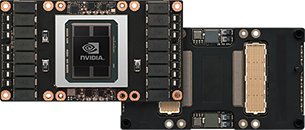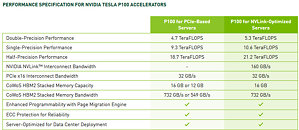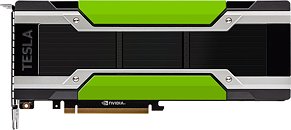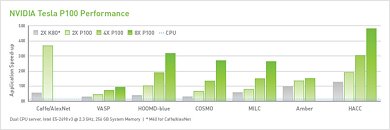Monday, April 10th 2017

NVIDIA Beats AMD to Market On HBM2 - Announces Tesla P100
NVIDIA has announced availability of their latest data center accelerator, the Tesla P100, which is the world's first HBM2-powered add-in-card. this means that NVIDIA effectively beat AMD in time to market with HBM2 technology, which AMD pioneered (in its HBM form) with the Fury line of graphics cards.NVIDIA naturally touts this as the world's most advanced data center accelerator, for workloads such as "Artificial intelligence for self-driving cars. Predicting our climate's future. A new drug to treat cancer." NVIDIA's green graphics show an almost 50x increase in computing power from 8x Tesla P100 accelerators when compared to a dual CPU server based on Intel's Xeon E5-2698 V3 (which isn't really all that surprising.) NVIDIA further brings in the PR talk with examples on how a single GPU-accelerated node powered by four Tesla P100s - interconnected with PCIe - can replace up to 32 commodity CPU nodes for a variety of applications - saving up to 70% in overall data center costs.
Source:
NVIDIA





105 Comments on NVIDIA Beats AMD to Market On HBM2 - Announces Tesla P100
Overpriced cards, even more money grabbed for adaptive sync, quickly diminishing support for older cards.
Please man, you're smarter than this. They're both huge multinationals making money off of us, one was luckier, and had the "privilege" of charging more because they could, the same goes for intel, actually intel is a better example, but i think neither nvidia nor intel made bad products and made you pay ridiculous prices for their products, not most of the time al least (titan is an absolute retarded joke, but ignore the price for a moment, is it a product you can call bad?), but AMD surely did more bad products than both of nvidia and intel, in the past, so at the end they both bend you over, just in different directions.
Like Vulcan. They already invested in Mantle. By giving it to the Khronos group they just made it easily and cheaply accessible to the rest of the industry. And msft was likely never to develop a truly multi thread API if they didn't have to. Meanwhile, their hardware was designed with a lot of programming needed to get the most out of it.
You know, up until some company started "me, ME; MEEEE; ONLY MINE" thing and it ended up with Microsoft DirectX wiping the floor with that standard.
All companies are out there for profits, but not all companies get as low as it gets, Huang is particularly good at it.
E.g. When ATI was top dog (Radeon 9000 days), they didn't give a rat's ass for Linux. They had their fglrx (which they got through an acquisition, iirc) which offered a sorry-ass OpenGL implementation and would barely support newer kernel or X servers and that was it. But I don't call them evil or something because of that. Neither do I think Nvidia were angels for providing a better Linux driver for years. It's just business.
www.techpowerup.com/227903/nvidia-tesla-p100-available-on-google-cloud-platform
What is it you're trying to do here, cheap clicks, Nvidia publicity, or are you really that uninformed?
Edit: the "old card" had 3840 shaders as well - no idea why some people are trashtalking about GPU's they don't know jack about.
Utterly senseless "news" here.
And indeed, while underdog is limited in harm it could do to the market, even Intel didn't go as low as nvidia did, in my opinion.
The Tesla P100 is a GPGPU with the most powerful GPU in existence - the NVIDIA GP100 "Pascal," featuring 3,584 CUDA cores, up to 16 GB of HBM2 memory.
And yes I agree, it's annoying when people act like they know what's going on, even to the point of calling someone out, when actually a few seconds reading the link they provided would show they don't know "jack" as you put it.
Still nobody else mentioning Vega up and running liquid sky's gaming system.
But that won't happen for a long time, they've got to get out of a big hole first.
And yes, sometimes companies learn and CEOs change, but again, that holds for all companies, it's not something AMD specific. But at the end of the day, companies are held accountable by their shareholders, not their customers. You can't simply decree "we're going to pour $10mn into developing this standard and then offer it for free". You have to have a business case for that.
Another example: do not, for a moment, think AMD priced Ryzen the way they did because of goodness of their hearts. They have models and projections that tell them those price points are the sweetspot for recuperating their investment while also gaining marketing share.
And there is no harm or disgrace in cheering for the underdog. I'd say it is reasonable to do so.
No they aren't.
Intel isn't like nvidia either, and that despite having oh so much more dominant position.
And even back, with market being rather close to 50/50 between team red/green, green was going full throttle shit (effectively killing OpenGL), while red didn't.
What you say is certainly true in markets with more competitors. But when only a handful are involved, they tend to act alike.